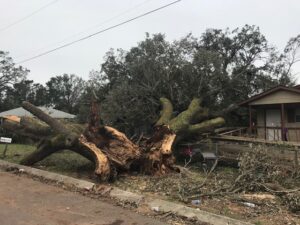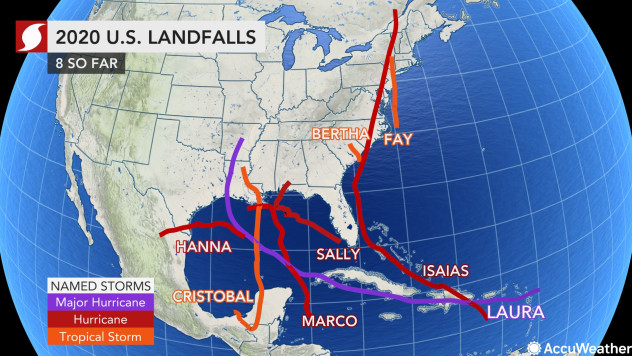Upwards of $3B insured damage

A downed tree misses one house but grazes the roof of the one next door in the aftermath of Hurricane Sally in Pensacola, FL, September 21, 2020
I returned last week from Pensacola, where I spent several days helping homeowners and other insurance consumers in recovery efforts from Hurricane Sally the week prior. The most severe wind damage seemed to be limited to areas near the coast or open bay waters. What I saw was mostly minor damage to roofs and siding, seldom structural, let alone catastrophic. At one point though, more than 500,000 residents were without power in Florida and neighboring Alabama, where the Cat 2 storm made official landfall, with maximum winds of 105 mph and up to 30 inches of rainfall. Storm surge was upwards of 7 feet in coastal Escambia County (Pensacola) and adjacent Baldwin County, Alabama.
AIR Worldwide, the Verisk catastrophe risk modeling firm, estimates Sally’s insured losses will range from $1 billion to $3 billion, with wind representing the majority of losses. This is exclusive of National Flood Insurance Program losses, which are expected to be especially steep in Alabama, given more than two thirds of flood coverage there is federal. AIR’s estimates include residential, commercial, industrial, and automobile property losses including contents. My Hurricane Update from last Monday includes pictures of flood inundation of upwards of three feet in downtown Pensacola and exclusive drone video and images from a few hours after Sally made landfall on September 16. You’ll also see the unfortunate damage caused by a loose barge to the newly built southbound span of the Pensacola Bay Bridge, linking Pensacola to Gulf Breeze, on the barrier beach.

Two big trees that seemed to know to fall away from nearby townhouses in the aftermath of Hurricane Sally in Pensacola, FL, September 21, 2020.
FEMA last week approved a major disaster declaration for the storm. It includes public assistance for all categories in Escambia County and public assistance Category B (emergency protective measures) for Bay, Calhoun, Franklin, Gadsden, Gulf, Holmes, Jackson, Liberty, Okaloosa, Santa Rosa, Walton, and Washington counties. The Florida Division of Emergency Management is continuing to conduct damage assessments in the 12 counties that did not receive all categories of Public Assistance. The Division is also conducting damage assessments at individual residences and businesses and will continue to work with FEMA to apply for Individual Assistance.
The Governor has activated the Florida Small Business Emergency Bridge Loan program through the Florida Department of Economic Opportunity to support small businesses impacted by Hurricane Sally. The program provides short-term loans up to $50,000, or in special cases $100,000, if warranted by the needs of the business.

Courtesy, AccuWeather
So we begin another process of filing and processing insurance claims. The state has activated the Emergency Adjuster Licensing System to boost the number of insurance adjusters available to help residents with claims. There are more than 150,000 adjusters currently licensed in Florida. This activation allows insurance companies to bring in catastrophe adjusters from other states to help handle the increased demand. Sally was the eighth named Atlantic storm to make landfall in the U.S. this hurricane season. As we enter this new week, there is no tropical cyclone activity in the Atlantic Ocean. Fingers crossed!
LMA Newsletter of 9-28-20

